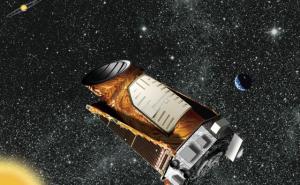An exoplanet, or extrasolar planet, is a planet outside our solar system. The first confirmed detection of such a planet occurred in 1992 [scientific paper]. Since then there have been 528 confirmed detections (as of 12th February 2011) with many more being added to the list on a constant basis. A full and updated catalogue of exoplanets can be found at The Extrasolar Planets Encyclopedia.
These planets are so far away and so faint that they can only be detected indirectly. Various detection methods exist; for example, you can look for a tiny wobble in a stars position caused by the gravitational pull of the orbiting planet, or you can look for a faint dimming of a star’s light as the orbiting planet passes in front. The NASA Kepler space observatory, launched in 2009, uses the latter method for its mission to discover Earth-like planets orbiting other stars.
The race is now underway to find that first “Earth-like” exoplanet, sometimes dubbed Earth-2.0 or the Goldilocks planet. Such a discovery seems now inevitable and only a matter of time, but when it comes will nonetheless surely be a moment of profound significance. This planet would have to be of similar size to the Earth and within an orbiting zone of its star that would allow for the existence of liquid water – the so-called “habitable zone“, and not be tidally locked i.e. not have one side of the planet always facing the star. Although the exact criteria for an Earth-like planet as well as how and when this discovery is likely to be announced is not altogether clear, see here.
The Kepler space-based telescope has already produced a windfall of potential candidates [scientific paper][BBC article].
Recently published results have thrown up surprising planetary configurations, such as a planetary system comprised of six planets in very close orbit to their star, causing astronomers to rethink theories on how planets are formed [scientific paper][BBC article].
There is still the possibility that a rouge planet (in interstellar space having been ejected from its planetary system) could support an ocean (kept warm by geothermal activity) beneath its frozen surface leaving open the intriguing possibility of life in unexpected corners of the universe. [scientific study][summary].
The discovery of multiple extrasolar planets (with estimates of at least 40% of solar-type stars having low-mass planets [BBC article]) has intensified interest in the possibility of extraterrestrial life. I shall leave this discussion for a future post.


